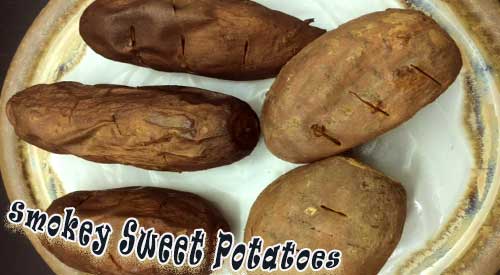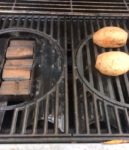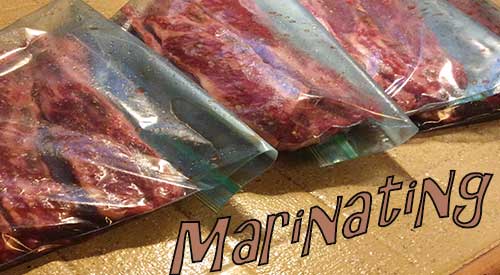 |
| Try our technique on Smokey Sweet Potatoes for a great addition to your BBQ! |
We introduced you to smoked potatoes some time ago giving you an easy method of smoking cubed potatoes . Now, we look at sweet potato, a very popular root vegetable that does particularly well on the grill. This time, we’ll smoke the potatoes whole to allow for versatility for recipes.
Get 5 or 6 sweet potatoes selected, preferably of equal size, and let’s get to the grill!
Choose Your Equipment
I’m going to use two pieces of equipment today to demonstrate how easily it is to work with what you own to add a smoke component.
For my gas grill, I’ll be using a smoker box equipped with 3-4 wood chunks in double filet size. For the charcoal grill, I’m incorporating both lump charcoal and briquet for the fuel and adding double filet wood chunks for flavor. My charcoal grill is a traditional kettle grill. Both these units are set up for two-zone cooking which means the fuel is on one side – in the case of the gas grill, burners are lit on one side only, for the charcoal grill, charcoal is banked to one side of the grill, using both lit and unlit coals to sustain the heat level. All cooking will be done on the side that does not have any direct heat.
 |
| #woodchunks |
With a target cooking temperature of 325-350°F, these sweet potatoes will cook up and get smoky in no time!
Tasting Notes: Preparation of the sweet potatoes prior to smoking is simple. Wash the potatoes well, pat dry, and then trim off the two ends. Using a knife, pierce the ends one time and the sides several times to provide injection areas for the smoke vapor. This will ensure an even smoke flavor.
No Work Grilling & Smoking Smokey Sweet Potatoes
Once the grill of your choice is set up, it’s just a matter of placing the whole potatoes on the grill grate, indirect side, and allowing them to tenderize. This will take about 75 minutes total. There is no need to do any rotation of the potatoes; just allow to infuse with flavor.
 |
| #twozonecooking |
If you’ve followed our recommendation for the charcoal grill – placing unlit charcoal/briquets on the direct side of the grill, lighting a chimney starter of charcoal, and pouring over the unlit coals when glowing hot, then adding the wood chunks – you’ll have plenty of fuel for the entire cook time.
Once tender, remove from the grill and set aside to use in your favorite sweet potato recipe. I’ll be making a smoked sweet potato and chipotle soup with mine, which we will post the recipe soon.
One important point is to know that the boldness of the smoke will be much greater from a charcoal grill than a gas/LP unit. You can see the difference on the skin of the potatoes that I’ve grilled today. Nevertheless, grilled and smoked sweet potatoes are full of sweet, smoky flavor you’ll want to enjoy all year long.
What’s your favorite sweet potato recipe? Leave us a comment to opine and subscribe to get all our postings on tips, techniques and recipes. Bringing innovation to wood fired cooking with recipes, techniques and the science behind the fire, smoke, and flavor. That’s SmokinLicious®.







